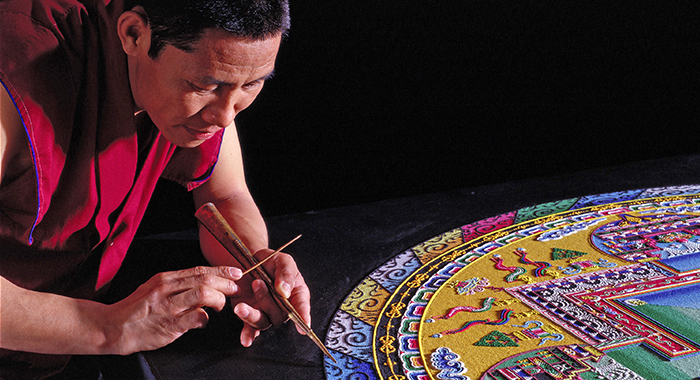Tibetan Monks Visit Campus to Share a Sacred Practice
A sacred form of art from the Tibetan Buddhist tradition will be created on campus, April 9-13. Eleven Tibetan Buddhist Monks of the Drepung Loseling Monastery will construct a sand mandala in the Norman Miller Center for Peace, Justice & Public Understanding. An opening ceremony will begin at 1 p.m. on Monday, April 9.
“Mandala” means circle in Sanskrit. The mandala is a sacred cosmogram used as an object of contemplation. The monks create a diagram and use small tubes to apply sand granules to complete their work of devotion – a work of art that depicts the pure nature of the world. By creating a sand mandala, Buddhists believe we bring the creative energy of that sacred dimension into our lives and attune ourselves to this natural perfection.
Experiential learning
Debbie Kupinsky (Art) arranged the monks’ visit to campus as part of her course in non-Western art.
“We live in an area where we don’t have access to a lot of museums,” Kupinsky explains. “That’s usually how people go about teaching those classes. I really like to have some kind of larger non-Western art event come here. Most of the art we look at it, Western art, is religious in nature and spiritually focused. The mandala is also like that.
“I want the students to be able to look at other types of things and think about how this may relate to how they feel about spirituality. The sand mandala is made of a non-permanent material. It talks about the impermanence of life (an essential doctrine in Buddhism). That is something they also think about.”
Members of the St. Norbert College community will have the opportunity to help create a second mandala in Michels Commons. One of the monks will provide instruction. The community sand mandala, sponsored by Multicultural Student Services, will be an ongoing event throughout the week.
Kupinsky hopes the sand painting attracts interest from the college community beyond art students and faculty.
“What I like is it’s very accessible,” she explains. “You can physically directly engage with it. If you wrote an article about Buddhism, it wouldn’t have the same effect.”
A week-long opportunity
Sand painting is part of a week of activities featuring the Buddhist monks. The programming was intentionally scheduled to coincide with Better Together Day, April 10, explains Bob Pyne (Miller Center): “[That’s] when we and other campuses associated with Interfaith Youth Core highlight the value of interfaith understanding and cooperation. For us, the sand mandala provides an opportunity for the SNC community to witness firsthand spiritual practices that they might otherwise only read about, and to contemplate the beauty, harmony and impermanence associated with the mandala itself.”
A lecture about the sacredness of the cosmogram, “The Symbolism of the Sand Mandala,” will be presented at 6 p.m. Tuesday, April 10, in Fort Howard Theater.
“Creating the mandala is like a form of meditation,” says Kupinsky. “There is actually Buddhist architecture laid out like the mandala. The mandala idea is really a three-dimensional universe flattened and made into this form. When people come into the Norman Miller Center, [the sand mandala] is a sacred activity. It’s like a form of prayer.”
The Center for Global Engagement will offer virtual-reality experiences, including the land formations found in Tibet, from 2:30 to 3:30 p.m. on April 10 in the Bemis International Center. Participants are asked to bring smartphones. Virtual-reality viewers will be provided.
The Tibetan monks will perform “The Mystical Arts of Tibet,” sacred music and dance for world healing, at 6 p.m. Thursday, April 12, in Walter Theatre. The performance will feature traditional Tibetan costumes and instruments.
And there it goes …
The closing ceremony for the monk’s own sand mandala creation will be held at 1 p.m. Friday, April 13. Once the mandala is complete, the deconstruction process begins. The sand will be brought to the Fox River as a ritual to return it to nature.
“I related dematerializing in my class to Plato (Theory of Forms, that non-physical forms represent reality),” says Kupinsky. “Plato believed that this is not the whole story. Behind this unreliable world of appearances is a world of permanence and reliability.”
April 5, 2018












